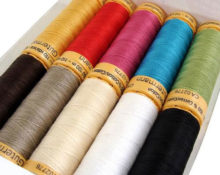Reinforced threads are used in those areas of clothing production where increased demands are placed on the strength and wear resistance of the finished product. In order to understand what influences these characteristics of fibers, it is necessary to understand the method of their production, additional processing and weaving. To figure out which seams this type of thread is used for, you should read the article.
Description of the thread reinforcement process
 Sewing threads are evenly twisted, long-length yarn fibers or thin threads used for sewing operations. Often, various manufactured items are subject to increased strength requirements. And this obliges the manufacturer to lay reliable seams. For that In order to achieve such indicators, the sewing industry must use threads that are characterized by increased strength, the so-called reinforced ones.
Sewing threads are evenly twisted, long-length yarn fibers or thin threads used for sewing operations. Often, various manufactured items are subject to increased strength requirements. And this obliges the manufacturer to lay reliable seams. For that In order to achieve such indicators, the sewing industry must use threads that are characterized by increased strength, the so-called reinforced ones.
This reinforced thread is made from:
- lavsan;
- cotton
The production technology is that the complex base, which is always made of polyester fiber, is braided with lavsan or cotton thin thread.
In addition, at the final stage of manufacturing, the entire product, when rewinding, is evenly immersed in a special solution, which is an organosilicon compound. This is done to increase the wear resistance and quality of the seam being laid.
Composition and properties of reinforced threads
 Reinforced thread can be 100% synthetic. In this case, it consists of polyester fibers and lavsan. There may also be an option when from 30 to 35% of the thread is cotton, and the rest is polyester (polyester) fibers.
Reinforced thread can be 100% synthetic. In this case, it consists of polyester fibers and lavsan. There may also be an option when from 30 to 35% of the thread is cotton, and the rest is polyester (polyester) fibers.
This combination of constituent fibers and the methods of their weaving give the products in which they are used for stitching the following characteristics:
- strength;
- abrasion resistance;
- the ability to succumb to a certain stretch;
- durability, even with intensive use.
It is the core of continuous polyester fiber that makes the thread more durable. That is, the use of such threads provides a certain guarantee that the seam, which is subjected to heavy loads of both tearing and abrasion, will not break through.
But the braid itself, be it lavsan or cotton, helps improve the sewing qualities of the thread. This part of the thread provides an even and smooth seam, which during operation prevents the polyester fiber from puckering the seam.
If we talk about resistance to temperatures, here we can give the following characteristics:
- melting occurs with a synthetic component at temperatures from 2500 C, while the lower sole of an iron heats up only to a maximum of 1700 C;
- if a thing with reinforced seams is immersed in boiling water, where boiling occurs, then this can lead to a slight shrinkage of the reinforced fiber, by only 1.5%.
Types of such threads and their markings
The general type of marking depends on the composition of the product. So, if only lavsan is contained, then the designation will be LL. If the contents are combined, then LH.
In addition to the letter designation, there is also a digital marking. The number in front of the letters indicates the linear textile density and the number of folds. For example:
- lavsan has the following designations - 25 LL, 35 LL, 45 LL, 75 LL, etc.
- cotton – 44 LH, 65 LH, 100 LH, 150 LH.
Where are such threads used and for what?
The number in the marking gives an idea of where this fiber can be used. Since the tailoring of each product has its own requirements for strength.
Important! Therefore, for both lavsan and cotton-lavsan, the number before the letter designation of the composition gives an idea of the scope of application.
Most often used for sewing:
 dense fabrics such as coats, draperies, canvas;
dense fabrics such as coats, draperies, canvas;- workwear;
- shoes;
- furniture;
- leather goods;
- covers for car, bus and other types of interiors;
- sewing shirt and blouse fabrics - for the most fragile 100% lavsan threads.
Important! Products from domestic manufacturers are manufactured strictly in accordance with GOST requirements for this type of product, so you can be completely confident that they comply with all the requirements.


 dense fabrics such as coats, draperies, canvas;
dense fabrics such as coats, draperies, canvas; 0
0





